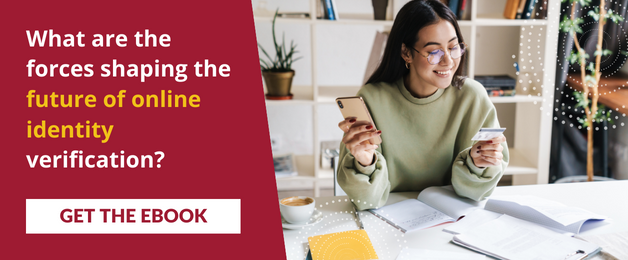Facial Recognition for Financial Applications

What is facial recognition?
Facial recognition is a type of biometrics technology that analyses facial data. It is used by businesses to help verify a person's identity, such as for financial applications like account opening and onboarding.
To confirm if a person's identity is genuine, facial recognition technology analyses their selfie against the photo on their passport, driver's licence or other ID documents. With a result returned in mere seconds, this automated technology helps make quick and efficient identity verification possible.
How does facial recognition work to verify identity?
Facial recognition works by extracting and measuring numerous data points from a facial image, like the distance between the lips and nose and the shape of the cheekbones.
When used for identity verification, these same calculations are performed against the photo on the identity documents to assess the probability of a match. A categorised points match algorithm considers all the different face measurements weighted by importance and calculates the likelihood that the applicant is the same person in their photo ID document.
Because many elements like hair colour, glasses, makeup and lighting might differ between a selfie and a photo ID, the facial recognition algorithms are trained to adjust for these variations. The more advanced systems use camera controls to capture the best possible images, so factors like low lighting or poor image resolution do not compromise accuracy. Technical improvements have also made it possible to develop protocols that remove the risk of race, age and gender bias.
Can facial recognition be fooled?
Facial recognition systems vary in sophistication, with some more easily fooled than others. Fraudsters go to extraordinary lengths to circumvent these systems, from using rudimentary techniques like holding up a photo of the person to be impersonated to the more complex task of replicating the face with a 3D model. Facial spoofing is the term given to fraudsters who try to pass off a fake face as a living person by using photos, videos, 3D models or 3D printed masks.
In order to protect against these threats, many facial recognition systems incorporate liveness and spoofing detection to validate whether the face is from a physically present, living, breathing human. This technology uses machine learning algorithms to interpret biometric data and find anomalies that can distinguish between real and fake faces to avoid any spoofing, deep fakes or presentation attacks.
Facial recognition with liveness
There are two types of liveness detection: active and passive. Active liveness requires the user to perform an action, such as moving their head in front of the camera. Passive liveness works off a static photograph, with the algorithms assessing parts of the image, such as light refraction, skin tone and the presence of cut-outs.
Using active and passive liveness detection in conjunction with each other achieves higher accuracy and a smoother user experience. Typically, the systems that combine both types of liveness work by assessing micro facial movements from a user's live video selfie where they are asked to smile or respond to a similar instruction.
Additional layers of verification should be used in tandem with facial recognition technology to strengthen its accuracy. For example, document fraud analysis, data verification and Optical Character Recognition (OCR) help businesses determine whether the ID documents are legitimate and create a better customer experience.
Why is facial recognition important?
Facial recognition improves the speed and security of financial applications and onboarding requirements for credit cards, utilities, mortgages and other portfolios. Benefits include:
- Better fraud protection: the increased sophistication of forged ID has made it harder for humans to spot whether a photo is genuine. Facial recognition algorithms combined with liveness detection can do this job more accurately in less time1. While there is no silver bullet to prevent identity fraud, authenticating users with facial recognition adds a vital layer to a company's fraud prevention strategy.
- Streamlined customer experience: facial recognition is considerably less cumbersome than requiring customers to visit a store or branch to show in-person identification. By removing this face-to-face requirement, application uptake has been reported to increase by as much as 40%2.
- Lower operational overheads: The laborious task of assessing photos to determine if the user is real and present at the time of the photo's capture is replaced with a fast, automated process. One Australian banking and finance customer reported an estimated saving of $3M3 in the annual operational cost by removing the face-to-face element of verifying identity.
- Enable efficient compliance: when used with data verification, liveness, and spoofing detection, facial recognition can help you to fulfil your Know Your Customer (KYC) and Anti-Money Laundering (AML) and Counter-Terrorism Financing (CTF) compliance requirements to identify and verify customers. Facial recognition also supports consent capture and ongoing customer due diligence.
Help to protect your business and customers from fraud and manage your operational overheads using Equifax Biometrics with facial recognition. Our Australian-owned and hosted solution remotely verifies a person's identity so companies can perform identity verification in a secure, convenient and user-friendly way.
To learn more about facial recognition and identity verification, get in touch with an Equifax Biometrics expert here, or download our short demo. You can also learn more on our Equifax Biometrics product page.
1Equifax Biometrics face matching takes 1-2 seconds, with a 99.997% accuracy.
2Reported by Australian banking and finance customers in 2021/2 pre and post implementation of Equifax Biometrics with facial recognition solution.
3Reported by Australian banking and finance customers in 2021/2 pre and post implementation of Equifax Biometrics with facial recognition solution.

